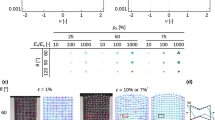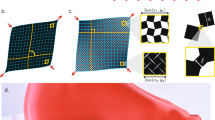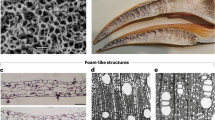Abstract
Rapid progress in additive manufacturing methods has created a new class of ultralight mechanical metamaterials with extreme functional properties. Their application is ultimately limited by their tolerance to damage and defects, but an understanding of this sensitivity has remained elusive. Using metamaterial specimens consisting of millions of unit cells, we show that not only is the stress intensity factor, as used in conventional elastic fracture mechanics, insufficient to characterize fracture, but also that conventional fracture testing protocols are inadequate. Via a combination of numerical and asymptotic analysis, we extend the ideas of elastic fracture mechanics to truss-based metamaterials and develop a general test and design protocol. This framework can form the basis for fracture characterization in other discrete elastic-brittle solids where the notion of fracture toughness is known to break down.
This is a preview of subscription content, access via your institution
Access options
Access Nature and 54 other Nature Portfolio journals
Get Nature+, our best-value online-access subscription
$29.99 / 30 days
cancel any time
Subscribe to this journal
Receive 12 print issues and online access
$259.00 per year
only $21.58 per issue
Buy this article
- Purchase on Springer Link
- Instant access to full article PDF
Prices may be subject to local taxes which are calculated during checkout




Similar content being viewed by others
Data availability
All data are available in the main text or the supplementary materials.
Change history
16 February 2022
A Correction to this paper has been published: https://doi.org/10.1038/s41563-022-01217-1
References
Valdevit, L., Pantano, A., Stone, H. A. & Evans, A. G. Optimal active cooling performance of metallic sandwich panels with prismatic cores. Int. J. Heat Mass Transf. 49, 3819–3830 (2006).
Chung, D. D. L. Composite Materials for Electrical Applications. Composite Materials: Science and Applications (Springer, 2003).
Tancogne-Dejean, T., Spierings, A. B. & Mohr, D. Additively-manufactured metallic micro-lattice materials for high specific energy absorption under static and dynamic loading. Acta Mater. 116, 14–28 (2016).
Zheng, X. et al. Ultralight, ultrastiff mechanical metamaterials. Science 344, 1373–1377 (2014).
Zheng, X. et al. Multiscale metallic metamaterials. Nat. Mater. 15, 1100–1106 (2016).
Bauer, J., Schroer, A., Schwaiger, R. & Kraft, O. Approaching theoretical strength in glassy carbon nanolattices. Nat. Mater. 15, 438–443 (2016).
Zheng, X. et al. Design and optimization of a light-emitting diode projection micro-stereolithography three-dimensional manufacturing system. Rev. Sci. Instrum. 83, 125001 (2012).
Cabrini, S. & Kawata, S. (eds) Nanofabrication Handbook (CRC Press, 2012).
Eckel, Z. C. et al. Additive manufacturing of polymer-derived ceramics. Science 351, 58–62 (2016).
Meza, L. R. et al. Resilient 3D hierarchical architected metamaterials. Proc. Natl Acad. Sci. USA 112, 11502–11507 (2015).
Kooistra, G. W., Deshpande, V. S. & Wadley, H. N. G. Hierarchical corrugated core sandwich panel concepts. J. Appl. Mech. 74, 259–268 (2007).
Deshpande, V. S., Ashby, M. F. & Fleck, N. A. Foam topology: bending versus stretching dominated architectures. Acta Mater. 49, 1035–1040 (2001).
Deshpande, V. S., Fleck, N. A. & Ashby, M. F. Effective properties of the octet-truss lattice material. J. Mech. Phys. Solids 49, 1747–1769 (2001).
Montemayor, L. C., Wong, W. H., Zhang, Y. W. & Greer, J. R. Insensitivity to flaws leads to damage tolerance in brittle architected meta-materials. Sci. Rep. 6, 20570 (2016).
Gu, H. et al. Fracture of three-dimensional lattices manufactured by selective laser melting. Int. J. Solids Struct. 180, 147–159 (2019).
O’Masta, M. R., Dong, L., St-Pierre, L., Wadley, H. N. G. & Deshpande, V. S. The fracture toughness of octet-truss lattices. J. Mech. Phys. Solids 98, 271–289 (2017).
Liu, Y., St-Pierre, L., Fleck, N. A., Deshpande, V. S. & Srivastava, A. High fracture toughness micro-architectured materials. J. Mech. Phys. Solids 143, 104060 (2020).
Anderson, T. L. Fracture Mechanics: Fundamentals and Applications 4th edn (CRC Press, 2017).
Tankasala, H. C., Deshpande, V. S. & Fleck, N. A. 2013 Koiter Medal Paper. Crack-tip fields and toughness of two-dimensional elastoplastic lattices. J. Appl. Mech. 82, 091004 (2015).
Huang, J. S. & Lin, J. Y. Mixed-mode fracture of brittle cellular materials. J. Mater. Sci. 31, 2647–2652 (1996).
Huang, J. S. & Gibson, L. J. Fracture toughness of brittle honeycombs. Acta Metall. Mater. 39, 1617–1626 (1991).
Hsieh, M. T., Deshpande, V. S. & Valdevit, L. A versatile numerical approach for calculating the fracture toughness and R-curves of cellular materials. J. Mech. Phys. Solids 138, 103925 (2020).
ASTM E1820 Standard Test Method for Measurement of Fracture Toughness (ASTM International, 2009).
Fuller R. B. Octet truss. US Patent 2,986,241 (1961).
Fleck, N. A., Deshpande, V. S. & Ashby, M. F. Micro-architectured materials: past, present and future. Proc. R. Soc. A 466, 2495–2516 (2010).
Fleck, N. A. & Qiu, X. The damage tolerance of elastic–brittle, two-dimensional isotropic lattices. J. Mech. Phys. Solids 55, 562–588 (2007).
ASTM E399-74 Standard Method of Test for Plane-Strain Fracture Toughness of Metallic Materials (ASTM International, 1997).
Bažant, Z. P. & Planas, J. Fracture and Size Effect in Concrete and Other Quasibrittle Materials (Routledge, 2019).
Nguyen, H. et al. New perspective of fracture mechanics inspired by gap test with crack-parallel compression. Proc. Natl Acad. Sci. USA 117, 14015–14020 (2020).
O’Dowd, N. P. & Shih, C. F. Family of crack-tip fields characterized by a triaxiality parameter—I. Structure of fields. J. Mech. Phys. Solids 39, 989–1015 (1991).
O’Dowd, N. P. & Shih, C. F. Family of crack-tip fields characterized by a triaxiality parameter—II. Fracture applications. J. Mech. Phys. Solids 40, 939–963 (1992).
Betegoǹ, C. & Hancock, J. W. Two-parameter characterization of elastic-plastic crack-tip fields. J. Appl. Mech. 58, 104–110 (1991).
Acknowledgements
We acknowledge funding from the Office of Naval Research (N00014-18-1-2658 and N00014-20-1-2504:P00001). H.C. and X.Z. also thank the NSF (2001677) and Air Force Office of Scientific Research (FA9550-18-1-0299) for funding support. A.J.D.S. is supported by the Cambridge-India Ramanujan scholarship from the Cambridge Trust and the SERB (Government of India). A.J.D.S. and V.S.D. thank S. R. Marshall and G. Smith for their help and support in the laboratory.
Author information
Authors and Affiliations
Contributions
V.S.D., X.Z. and M.O’.M. conceived and designed the research. H.C. developed the 3D printing platform, fabricated the octet-truss specimens and performed experiments. V.S.D. and A.J.D.S. designed the experiments (in situ XCT with multiaxial loading for fracture toughness measurements, digital volume correlation and imperfection analysis from XCT dataset) and the analytical formulations. A.J.D.S. performed these experiments, the numerical calculations and data analysis. V.S.D. and A.J.D.S. wrote the first draft of the manuscript. All authors participated in revising the manuscript, discussion and interpretation of the data.
Corresponding authors
Ethics declarations
Competing interests
The authors declare no competing interests.
Peer review
Peer review information
Nature Materials thanks Bin Liu, Yang Lu and the other, anonymous, reviewer(s) for their contribution to the peer review of this work.
Additional information
Publisher’s note Springer Nature remains neutral with regard to jurisdictional claims in published maps and institutional affiliations.
Extended data
Extended Data Fig. 1 Imperfection analysis.
(a) CAD model for the \(\bar \rho\) = 0.1 specimen with strut diameter 2r0=65 μm along with (b) an optical image of the printed specimen. (c) XCT image of the entire specimen comprising ~64,000 unit cells with the inset showing a more detailed view of a single unit cell within the specimen. (d) A magnified view of a larger region in the specimen in (c) with each location within the solid material shaded by the diameter D of the best-fit sphere at that location. (e) Probability density of diameters D within the entire specimen. The two modes correspond to best-fit spheres within the struts and node regions as marked. (f) The printed specimen was divided into 27 sub-cubes as shown, (g) cut and (h) then each individual cube was separately imaged via XCT to determine the distribution of the diameter D of the best-fit spheres as before. (i) The measured probability density function of D over the 27 sub-cubes is shown by the shaded zone with the solid line giving the mean over the 27 separate sub-cubes.
Extended Data Fig. 2 Uniformity of mechanical properties.
(a) Optical image of the printed specimen and (b) sketches depicting tensile testing along x, y and z− directions where z is the build direction. The measured tensile responses for the (c) \(\bar \rho\) = 0.1 and (d) \(\bar \rho\) = 0.02 specimens in the x, y and z− directions. Predictions based on the measured properties of a single strut (Supplementary Fig. 2) are included in (c) and (d). (e) The specimen cut into 27 sub-cubes and (f) uniaxial tensile tests were conducted on each cube along the (g) z− direction. The measured responses are shown in (h) and (i) for the \(\bar \rho\) = 0.1 specimen with two different choices of unit cell dimensions. The shaded zone depicts the variation over the 27 sub-cubes with the solid line the mean measured response.
Extended Data Fig. 3 Fracture mechanism maps.
Fracture mechanism maps of the stretch-dominated (a) isotropic compound simple cubic (SC) and body centered-cubic (BCC) truss (b) anisotropic compound SC/BCC truss (c) bend-dominated gyroid and (d) a topology selection map indicating which topology maximizes \(\bar K_{IC}/\varepsilon _f\) in different regions of the \(\bar \rho /\varepsilon _f\) versus \(\bar T\)space.
Extended Data Fig. 4 Design with metamaterials.
(a) Octet-truss beam of aspect ratio L/W = 20 with the embedded crack (a/W = 0.2) subjected to four-point bending. (b) Geometry of the continuum anisotropic elastic beam used to determine the calibration factors YI and \(\hat{T}\) for KIand T, respectively. (c) The cross-plotted fracture map from Fig. 3e. (d) Prediction of the normalized failure load P̄f of the \(\bar \rho\) = 0.08 octet-truss over a range of crack sizes and two choices of parent materials. The reference prediction for an assumed \(\bar T\)= 0 is also included. The black markers in (c-d) show examples of the prediction of the normalized failure load P = Pf for a crack with \(a/\ell = 16\) in a \(\bar \rho\) = 0.08 octet-truss metamaterial beam made from parent materials with εf = 0.025 and 0.1. (e-g) Topology selection for maximizing failure load under four-point bending. (e) The four candidate topologies with their orientations labelled in the global beam co-ordinate system (X,Y,Z). (f) Continuum calibration of the geometric constants YI and \(\hat{T}\) and (g) description of the optimal topology and improvement over the next best candidate for a \(\bar \rho\) = 0.08 beam made from a parent material with failure strains εf = 0.025 and 0.1.
Extended Data Fig. 5 Fracture process zone and crack propagation.
(a) Tensile loading of the \(2B = 1\ell\) specimen (\(a/\ell = 10\), \(\bar \rho\) = 0.1) and the corresponding (b) measurement and FE prediction of the tensile stress versus strain response. (c) High-speed photographs and corresponding FE predictions of crack propagation beyond peak stress with time t = 0 corresponding to the instant of the initiation of crack propagation at peak stress. (d) DVC measurements and (e) FE predictions of the distributions of the von-Mises strains εe within struts around the crack-tip. Measurements and predictions are shown at two load levels just prior to peak load marked in (b). The scale bar is applicable for the strains in c, d and e.
Supplementary information
Supplementary Information
Supplementary Sections A–H, Figs. 1–13, Tables 1 and 2 and captions for Videos 1–4.
Supplementary Video 1
The crack flank and front in the as-manufactured \(\bar \rho = 0.03\) and \(a/\ell = 4\) embedded crack specimen.
Supplementary Video 2
Tensile fracture of the crack front struts in the \(\bar \rho = 0.08\) and \(a/\ell = 10\) embedded crack specimen loaded to \(K_{\mathrm{I}} = K_{\mathrm{Ic}}\).
Supplementary Video 3
Buckling of struts over the crack flank in the \(\bar \rho = 0.03\) and \(a/\ell = 4\) embedded crack specimen loaded to \(K_{\mathrm{I}} = K_{\mathrm{Ic}}\).
Supplementary Video 4
The \(2B = 100\,{{{\mathrm{unit}}}}\,{{{\mathrm{cells}}}},\) \(\bar \rho = 0.10\) and \(a/\ell = 10\) specimen with a through-thickness crack loaded to \(K_{\mathrm{I}} = K_{\mathrm{Ic}}\) showing the fracture of surface struts while struts within the specimen remained intact. In the video, we show a slice consisting of the free surface and five layers in thickness instead of the entire 100 layers of thickness.
Rights and permissions
About this article
Cite this article
Shaikeea, A.J.D., Cui, H., O’Masta, M. et al. The toughness of mechanical metamaterials. Nat. Mater. 21, 297–304 (2022). https://doi.org/10.1038/s41563-021-01182-1
Received:
Accepted:
Published:
Issue Date:
DOI: https://doi.org/10.1038/s41563-021-01182-1
This article is cited by
-
Isogeometric analysis of architected materials and structures
Engineering with Computers (2024)
-
Mechanical metamaterials and beyond
Nature Communications (2023)
-
Prediction and control of fracture paths in disordered architected materials using graph neural networks
Communications Engineering (2023)
-
Multiscale modeling of functionally graded shell lattice metamaterials for additive manufacturing
Engineering with Computers (2023)
-
Plate-based cylinder metamaterial with negative Poisson’s ratio and outstanding mechanical performance
Science China Technological Sciences (2023)



